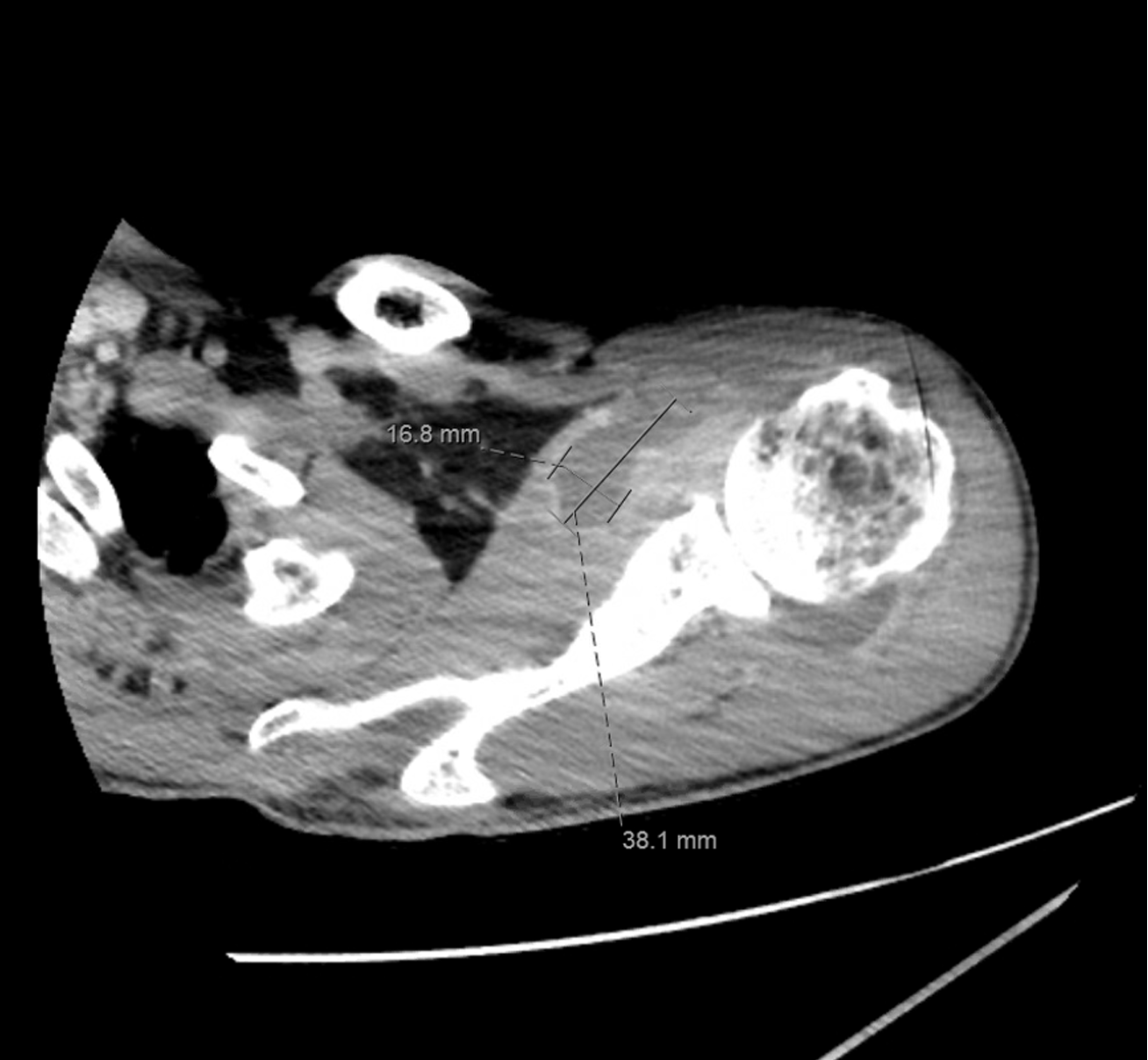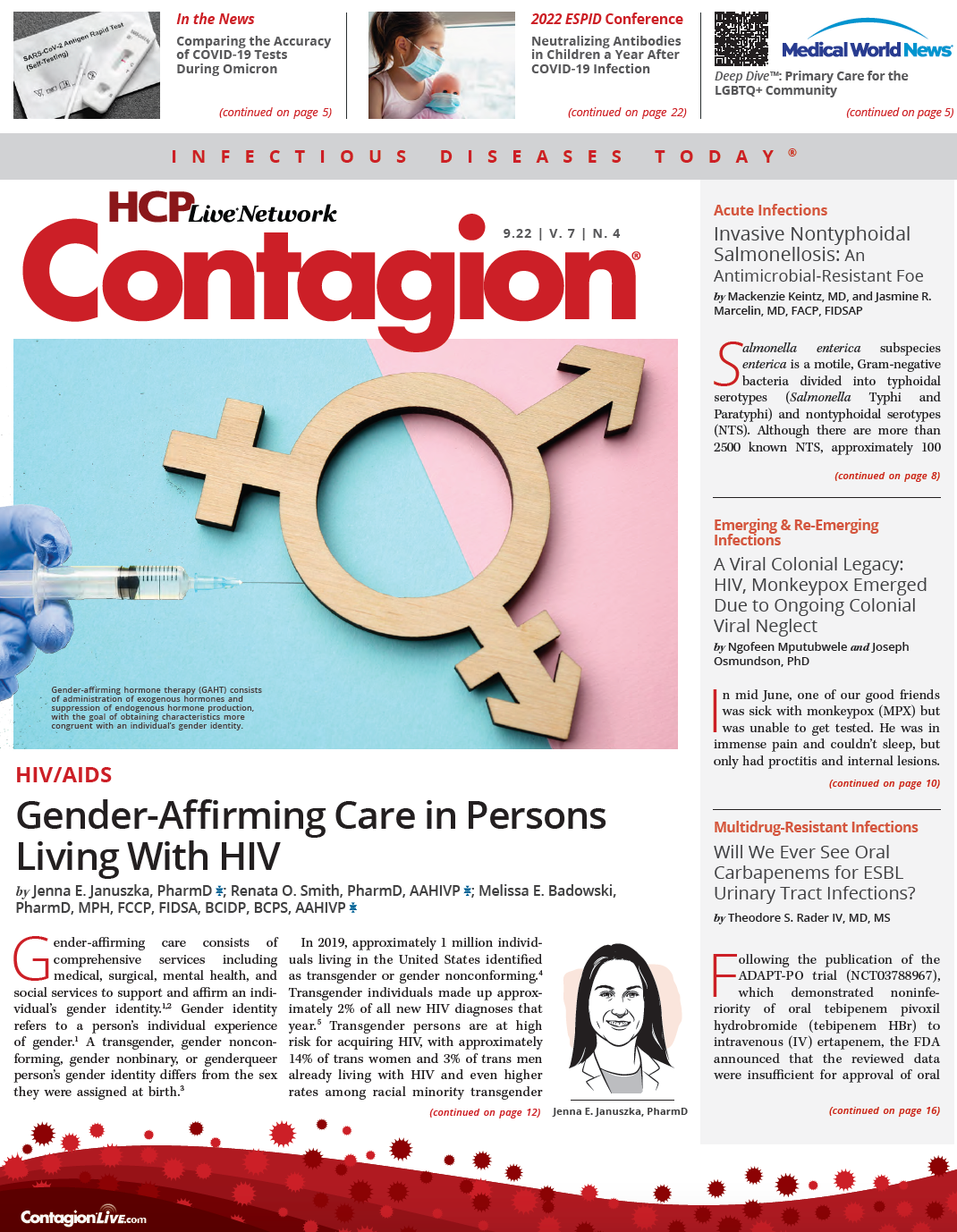Disseminated Gonococcal Infection Complicated by Suspected Osteomyelitis of Humeral Head
Gonococcal septic polyarthritis is an uncommon manifestation of N gonorrhoeae infection, but has increased by about 40% in recent years.
FINAL DIAGNOSIS:
Gonococcal septic polyarthritis
Transverse section of the left upper extremity showing a large left joint effusion and evidence of diffuse synovitis. There is a deep contour deformity of the humeral head demonstrating cortex that is indistinct as well as possibly irregular, concerning for osteomyelitis.

HISTORY OF PRESENT ILLNESS:
A 33-year-old man presented to the emergency department with a chief complaint of pain in the right wrist and left shoulder that began 3 weeks prior to presentation. The pain in both joints began at the same time and had been preceded by an intense workout. It was persistent, severe, and refractory to nonsteroid anti-inflammatory drug use. The right wrist had associated swelling and erythema, whereas the left shoulder had no associated findings on presentation. Subsequently, the patient developed similar pain in the left ankle, with associated swelling, erythema, and decreased range of motion. The patient denied any trauma to the joints, history of autoimmune disease, and recent upper respiratory or systemic symptoms. Notably, the patient also denied any history of urinary frequency, urgency, or skin findings of the genitals.
The patient was previously seen in our emergency department 3 days earlier with a similar presentation. At that time, urine Chlamydia trachomatis/Neisseria gonorrhoeae amplification testing, syphilis antibody cascading reflex, HIV fourth-generation antigen/antibody screen, and hepatitis C virus antibody screening were negative. He was afebrile and his white blood cell (WBC) count was 10.1 k cells/mm3 (normal, 4.0-11.0 k cells/mm3). At that time, he was given intravenous (IV) ketorolac and IV fluids, then discharged to home.
PAST MEDICAL HISTORY:
He has a history of gunshot wound to the chest with residual foreign bodies, which did not require intervention.
EPIDEMIOLOGIC FACTORS:
The patient endorsed sexual activity with multiple male partners without use of barrier protection. He has a previous history of injection drug use with fentanyl and was placed in inpatient rehabilitation treatment 1 month prior to presentation. Methamphetamine use was also noted. The patient reported a past history of ethanol use, although none in the 6 weeks prior to admission. He denied any known family history of autoimmune disease.
PHYSICAL EXAMINATION:
On admission to the hospital, the patient was febrile to 101 °F and tachycardic with a pulse of 105 beats per minute; on exam, he was in no acute distress. Exam of the right wrist revealed tender swelling of the volar aspect of the wrist. Examination of the left shoulder revealed significant tenderness of the left deltoid and pain radiating to the biceps, as well as warmth and decreased range of motion. Examination of the left ankle demonstrated effusion, warmth, and limited range of motion secondary to pain.
STUDIES:
Initial studies from the emergency department were notable for elevated C-reactive protein at 12 mg/dL (normal 0.4 mg/dL), leukocytosis of 11.6 k cells/ mm3 (normal, 4.0-11.0 k cells/mm3), and thrombocytosis of 959 k platelets/mm3 (normal, 150-450 k platelets/mm3).
The left ankle effusion was aspirated in the emergency department, and synovial fluid WBC count was found to be 150,000 white blood cells/mm3, with 88% neutrophils. X-ray imaging of the right wrist, left ankle, and left shoulder was largely unrevealing but demonstrated no fractures or traumatic injury.
CT of the left upper extremity demonstrated a large left shoulder joint effusion with diffuse synovitis likely reflecting septic arthritis and multiple fluid collections adjacent to the effusion within the superior aspect of the subscapularis recess of the glenohumeral joint. It also revealed irregular cortex of the humeral head and small focal areas of erosion, concerning for humeral osteomyelitis (FIGURE 1).
HOSPITAL COURSE:
The patient was initially treated with vancomycin and piperacillin/ tazobactam, and he underwent joint aspiration of the left ankle. His initial leukocytosis resolved within the first day of admission to 8.7 k cells/mm3. By hospital day 4, the synovial fluid culture from the left ankle was growing Gram-negative rods, and the primary team narrowed coverage to piperacillin/tazobactam alone.
On hospital day 5, the culture speciated to N gonorrhoeae with resistance to ciprofloxacin and intermediate sensitivity to tetracycline. Treatment was switched to ceftriaxone for a planned course of 10 days. Because of a lack of improvement in pain and range of motion in the left shoulder despite adequate antibiotic therapy, the infectious diseases service was consulted on hospital day 9 and recommended a CT scan of the left upper extremity to further evaluate. This test showed a joint effusion and findings concerning for osteomyelitis of the humerus, as indicated above. Orthopedic surgery was consulted, and they determined there was no need for acute surgical intervention, as the patient appeared to be improving clinically on antibiotics alone.
On hospital day 12, interventional radiology performed an ultrasound-guided drainage of the left shoulder effusion, a sample of which was sent for culture. Cell count of the synovial fluid from the left shoulder demonstrated 28,000 white blood cells/mm3, with 77% neutrophils and 110,000 red blood cells/mm3. The synovial fluid culture from the left shoulder did not grow any organisms.
By the time of hospital discharge, the patient had received 1 week of appropriate IV antibiotic therapy. The infectious diseases service recommended oral cefixime to complete a total antibiotic course of 3 weeks for disseminated gonococcal infection, with a plan to reassess as an outpatient to determine an ultimate duration of therapy for possible osteomyelitis.
The patient followed with rheumatology as an outpatient 2 weeks after discharge and was noted to still have pain and decreased range of motion in the left shoulder despite ongoing antibiotic therapy. However, he was subsequently lost to follow-up with infectious diseases and orthopedics.
DISCUSSION:
We present the case of a 33-year-old man with disseminated gonococcal infection (DGI), with imaging findings concerning for osteomyelitis of the left humeral head. Our patient was suspected to have contiguous osteomyelitis of the left humeral head based on positive synovial fluid culture from the left ankle and imaging of the left shoulder that demonstrated a large joint effusion, with evidence of diffuse synovitis and possible osteomyelitis.
Although possibly representative of trauma from a gunshot wound, without growth of other pathogens from culture of the left shoulder synovial fluid, an infection of the shoulder driven by N gonorrhea was felt to be most likely. DGI is an uncommon manifestation of an infection from N gonorrhoeae. Studies from the 1970s found an incidence rate of 0.5% to 3.0%,1 although this is currently suspected to be lower because of the decrease in prevalence of the implicated strain and overall decline in gonorrheal infection rates in the interim.2
DGI has historically been more common in women (particularly those who were pregnant or within 7 days of menses),3 but there may be a shift within the past 20 years to more equal distribution between genders or even male predominance.4 Bone involvement had been previously described in studies dating back to at least the 1920s5; however, in the current era of antibiotics, osteomyelitis due to N gonorrheae appears to be quite rare, with 2 reviews of the literature yielding less than 20 case reports.6
There are 2 common presentations for DGI: (1) a syndrome of polyarthralgias, dermatitis, tenosynovitis and (2) monoarticular or pauciarticular suppurative arthritis.2 As in the case with our patient, there are often minimal genitourinary symptoms.3
Interestingly, prior studies had noted that culture growth of N gonorrhoeae from blood and synovial fluid cultures was nearly exclusive in that those with primarily dermatitis and tenosynovitis were much more likely to have positive blood cultures,3 and those with a demonstrable joint effusion on physical exam were more likely to have only a positive synovial fluid culture.
The pathogenesis of DGI and osteomyelitis due to N gonorrhoeae remains uncertain, although delay in time of diagnosis may be an important factor.7 Treatment for gonococcal osteomyelitis is not well defined. Duration and selection of antibiotics are varied, from 1 week of IV ceftriaxone to 12 months of therapy with unresolved symptoms.8,9
Recent literature, including the OVIVA trial (NCT00974493), has suggested that an oral regimen may have similar failure rates as compared with IV antibiotics for orthopedic infections at 1 year.10 In our patient, it was not clear whether the imaging findings represented true osteomyelitis, so rather than expose the patient to potential adverse effects, our plan was to reassess and repeat imaging studies prior to completion of 3 weeks of therapy for DGI, but the patient was lost to follow-up.
Rates of gonorrhea infections have increased in the United States over the past 5 years; when adjusted for population, the incidence has increased by 40% from 2016 to 2020.11 There is also growing concern for the development of resistant strains of this pathogen.12,13 Based on these factors, it is reasonable to anticipate an increase in the number of cases of DGI.
Thus, when developing a differential for polyarticular joint pain, medical providers should be familiar with less common clinical manifestations of infection from N gonorrhea, including musculoskeletal presentations such as osteomyelitis.
References
- Barr J, Danielsson D. Septic gonococcal dermatitis. Br Med J. 1971;1(5747):482-485. doi:10.1136/bmj.1.5747.482
- Rice PA. Gonococcal arthritis (disseminated gonococcal infection). Infect Dis Clin North Am. 2005;19(4):853-861. doi:10.1016/j.idc.2005.07.003
- O’Brien JP, Goldenberg DL, Rice PA. Disseminated gonococcal infection: a prospective analysis of 49 patients and a review of pathophysiology and immune mechanisms. Medicine (Baltimore). 1983;62(6):395-406.
- Belkacem A, Caumes E, Ouanich J, et al. Changing patterns of disseminated gonococcal infection in France: cross-sectional data 2009-2011. Sex Transm Infect. 2013;89(8):613-615. doi:10.1136/sextrans-2013-051119
- Cooperman MB. End results of gonorrheal arthritis: a review of seventy cases. Am J Surg. 1928;5:241-252. doi:10.1016/S0002-9610(28)90007-0
- Russ-Friedman C, Coates K, Torabi M, Palavecino EL, McNeil CJ. Neisseria gonorrhoeae septic arthritis with contiguous infection consistent with acute osteomyelitis. Sex Transm Dis. 2020;47(9):e36-e38. Published correction appears in Sex Transm Dis. 2021;48(7):e101.
- Black JR, Cohen MS. Gonococcal osteomyelitis: a case report and review of the literature. Sex Transm Dis. 1984;11(2):96-99.
- Gharamti AA, Pinto NC, Henao-SanMartin V, Franco-Paredes C, Henao-Martínez AF. Successful treatment of gonococcal osteomyelitis with one week of intravenous antibiotic therapy. Int J STD AIDS. 2019;30(6):610-612. doi:10.1177/0956462418816496
- Rehnström M, Unemo M, Tunbäck P. Gonococcal osteomyelitis resulting in permanent sequelae. Acta Derm Venereol. 2016;96(4):562-563. doi:10.2340/00015555-2296
- Li HK, Rombach I, Zambellas R, et al. Oral versus intravenous antibiotics for bone and joint infection. N Engl J Med. 2019;380(5):425-436. doi:10.1056/NEJMoa1710926
- Sexually transmitted disease surveillance, 2020. CDC. Reviewed May 9, 2022. Accessed August 1, 2022. https://www.cdc.gov/std/statistics/2020/tables.htm
- Unemo M, Shafer WM. Antimicrobial resistance in Neisseria gonorrhoeae in the 21st century: past, evolution, and future. Clin Microbiol Rev. 2014;27(3):587-613. doi:10.1128/CMR.00010-14
- Workowski KA, Bachmann LH, Chan PA, et al. Sexually Transmitted Infections Treatment Guidelines, 2021. MMWR Recomm Rep. 2021;70(4):1-187. doi:10.15585/mmwr.rr7004a1

